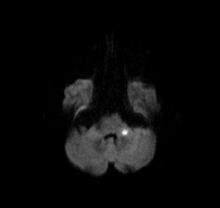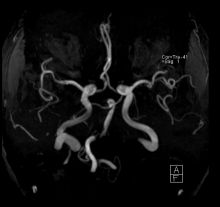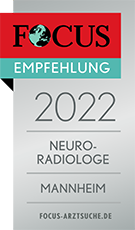
Every year about 350000 people suffer from a stroke in Germany alone. This is usually caused by a circulatory disorder in the brain that leads to brain tissue death (ischemic stroke). The second leading cause is cerebral haemorrhages. A stroke often leads to disability and care dependency in the long-term.
The causes of circulatory disorders may vary.
Atherosclerosis is the most common cause of stroke
Circulatory disorders of the brain (also: arteriosclerosis) are often caused by atherosclerosis. The term atherosclerosis describes vascular changes with deposits of fats, cells and calcium carbonate in the vessel wall (plaque). The consequences can be constrictions with a reduction in the blood supply (stenoses) on the one hand and may cause the plaque to break open (rupture) and blood clots (thrombus) to form on the other hand.
Vascular constrictions can lead to a chronic insufficient supply of blood to the brain. Firstly, an acute insufficient supply (ischemic stroke) may occur if the constriction is accompanied by lowered blood pressure, thus causing the oxygen to the brain to fall below a critical threshold. Secondly, a blood clot being formed may cause the vessel to close when a plaque ruptures or the clot may be carried away by the bloodstream and cause a brain vessel to close (embolism).
Timely diagnosis of atherosclerosis: MR and CT angiography

Changes in carotid arteries (carotid and vertebral arteries) supplying blood to the brain can be detected and quantified using duplex ultrasound, MR angiography and CT angiography.
Intra-cranial vessels can best be examined using MR angiography, or alternatively using CT angiography. The duplex ultrasound is not very well suited to vessels inside the skull.
If constrictions are detected, usually drug therapy, or possibly vascular surgery or catheter treatment is initiated.
Stroke diagnosis
MRI (magnetic resonance imaging / MRI) is the most accurate and the most appropriate method for the diagnosis of changes in the brain that have been caused by chronic or acute circulatory disorders.
An acute circulatory disorder in the brain can be detected by a so-called diffusion-weighted MRI in the first minutes. This is important because an incipient stroke often causes uncharacteristic symptoms, which often delay treatment at an early stage. A precise differentiation of the symptoms is therefore important in order to avoid incorrect treatment.
In hospital, strokes are treated in the acute phase, if possible in a specialised stroke unit. After a stroke, causal treatment is important to prevent further strokes.
A vascular diagnosis should be carried out to clarify the cause in order to detect constrictions and plaques. This is the primary role of MR angiography, CT angiography and Doppler sonography. In addition, the cardiac condition should be clarified in order to be able to detect cardiac arrhythmias, blood clots in the heart and anatomic peculiarities which may trigger an embolism.
Stroke symptoms
As the name suggests, a stroke usually occurs abruptly. Nevertheless, often temporary warning signs usually appear in the medical history that are often ignored:
- Numbness in the arm or leg, weakness of an arm or leg, possibly combined
- Disorders of speech production or speech comprehension
- The occasional inability to read, to count or to write.
- Vestibular disorders, possibly accompanied by dizziness.
- Vision and hearing impairments.
You should immediately consult a doctor or clinic on the occurrence of such complaints in order to initiate a neurological examination and further examinations, if necessary. You can only preserve and protect your health completely at an early stage.
Further vascular diseases: Aneurysms, malformations and thrombosis
An aneurysm is a sac belonging to an artery, which is either congenital or caused by changes in the vessel wall. The danger of aneurysms lies in the fact that it tends to burst (rupture), resulting in a brain haemorrhage. A cerebral haemorrhage usually manifests itself as a violent, sudden headache (in English ‘thunderclap’, thunderclap-like) or in more severe cases in sudden neurological deficits (paralysis, speech disorder, etc.), or even coma.
Already ruptured aneurysms should be treated without fail due to the risk of another rupture.
Treatment may be useful in the case of non-ruptured aneurysms. This all depends on the location of the aneurysm, the size, shape and individual factors.
Aneurysms can either be treated through the vascular system using a millimetre-thin plastic tube with a closing mechanism with platinum coils (coiling), or the aneurysm neck can be closed with a blood vessel clamp during an operation (clipping).
Lacerations in a brain artery can lead to a stroke in even rarer cases. This can arise, for example, on the floor of pathological protrusions in the vessel walls (aneurysms). Such lacerations result in bleeding in the area surrounding the vessel. This is usually caused by a sudden rise in blood pressure. People with hypertension are particularly at risk.
Aneurysms of the cerebral vessels usually remain undetected until bleeding starts. Headaches may be a warning sign, but very few headaches are caused by aneurysms. Aneurysms occur more frequently in patients with poly-cystic kidney disease and certain weaknesses of the connective tissue. A screening examination is useful in patients using MR angiography. It is important to also scan for aneurysms in relatives of patients with aneurysms, since a predisposition to aneurysm formation can be hereditary.

